It’s an ocean battle! Barracuda vs. Stingray: Which creature would win in an animal showdown?
Some anglers seek out great barracudas just because of the challenging fight they put up. These fish have few predators and only worry about giant creatures like sharks, goliath grouper, and tuna. The great barracuda’s scientific name is Sphyraena.
Sphyraena is Latin for “pike-like fish.” Globally, great barracudas are known by nicknames such as “bara” and “snoek.”
Next, let’s meet the stingray. It has a flat body and a venomous tail with a barb. There are different kinds of stingrays, each with its own size and special features. The stingray is skilled at hiding in sandy or muddy areas and has sharp senses to find prey in the sand. While usually docile, the stingray can and will defend itself when there’s a threat.
Who do you think will win? Will it be the barracuda or the stingray? Let’s see. Follow along to see which animal has what it takes to be the champion!
Barracuda vs. Stingray: Key Factors in an Animal Battle

The key factors for this animal showdown will be speed, size, attack strategy, defenses, and strength. We’ll also examine each competitor’s camouflage and special abilities. Here’s a table that breaks everything down. Take a peek before choosing your team!
| Battle Factors | Barracuda | Stingray |
|---|---|---|
| Speed | 27 mph | 15 mph |
| Size | 2 to 5 feet in length | Size varies, ranging from a few inches to several feet wide |
| Attack Strategy | Strike with lightning-fast attacks, Sharp teeth | Flat bodies they can bury in the sand |
| Defense Mechanism | Agility and speed | Rough skin and venomous spines |
| Strength | Strong jaws for overpowering prey | Muscular wings and venomous spines |
| Camouflage | Silver or greenish-gray coloration, aiding in stealth | Flat bodies they can bury in sand |
| Habitat | Tropical and subtropical oceans worldwide | Shallow coastal areas and coral reefs Areas with sandy bottoms |
| Special Abilities | Speed, agility, and sharp teeth | Barbed tail and strong wings |
Competitor Overview: Barracuda vs. Stingray
Let’s meet both of our fighters! First, we have an intimidating fish with two rows of teeth and a pointed snout; the infamous barracuda. These long, slender fish can reach up to 6 feet long and weigh over 100 pounds. The largest barracuda ever caught by rod and reel weighed 103 pounds and measured 5.5 feet long.
You can identify the barracuda by its gray and blue coloring on top and silver bottom, which helps them camouflage perfectly into their environment. These fish also have a crescent tail fin and small fins towards their back, which help facilitate swift movement as they speed through the water.
Our second competitor is the stingray. Stingrays are a flat type of fish that have diamond-shaped bodies. Their exact size can vary from one species to the next. Some stingrays are only a few inches, while others are up to 6.5 feet wide. Their flattened bodies are perfect for hiding in the sand, and their tails have venomous barbs or stingers.
Animal Battle Location: Barracuda vs. Stingray Habitat
Where will this animal battle take place? It depends if the fight is happening on the barracuda’s turf or the stingrays. Let’s dive a little deeper by looking at their natural habitats.
Barracuda Habitat
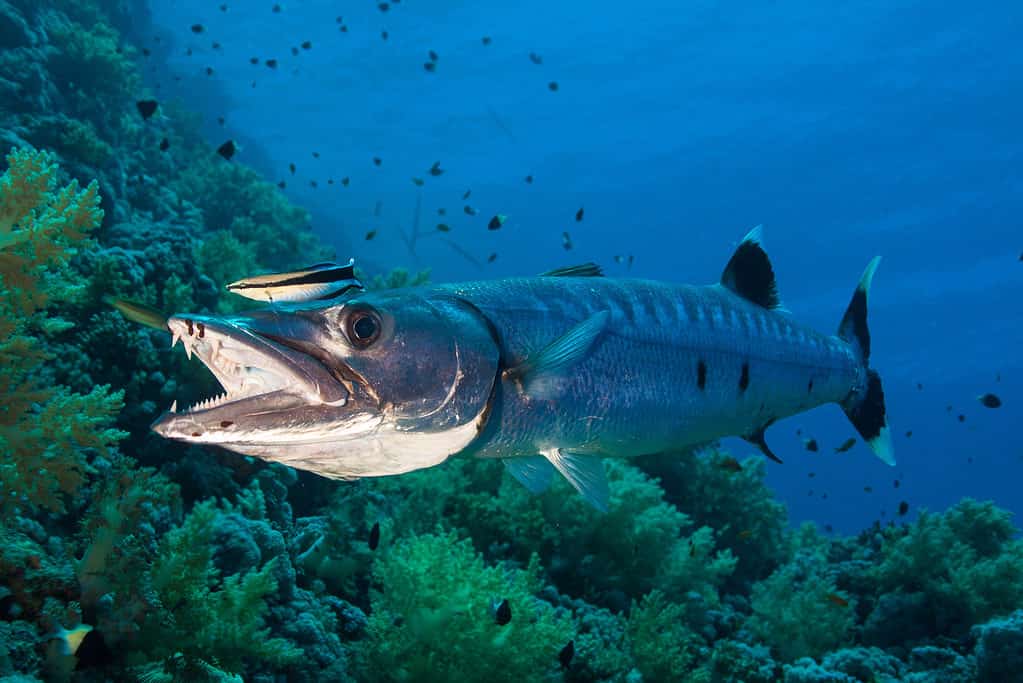
Barracudas can thrive in various habitats, including coral reefs, seagrasses, and mangroves.
©Itstvan Kovacs/Shutterstock.com
Barracudas like to inhabit tropical and subtropical oceans worldwide. They are fast swimmers and can be found near the water surface or as deep as 300 feet. Some of their favorite habitats include mangroves, seagrasses, and coral reefs. When it gets cold outside, some species migrate to warmer waters.
Juvenile barracudas live in safe spots like mangroves and seagrass beds, which provide cover when hiding from predators. They can begin moving to deeper reef areas once they reach about two years of age.
Stingray Habitat
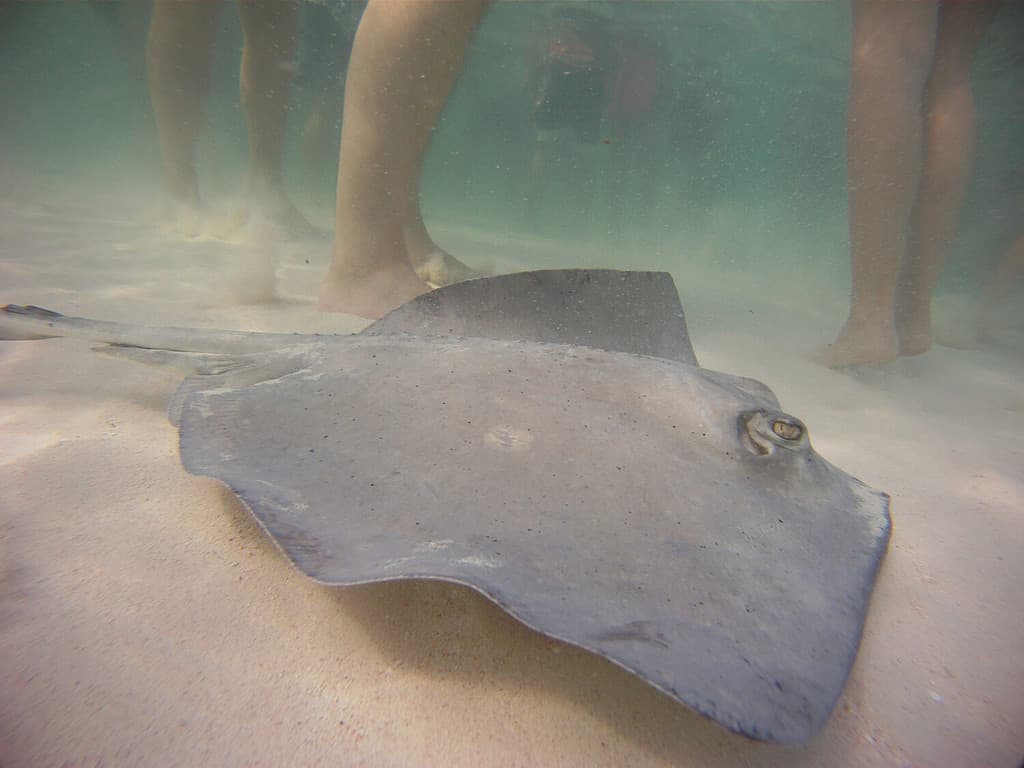
Stingrays prefer areas with sandy bottoms.
©Drop Zone Drone/Shutterstock.com
Stingrays live in all habitats, including estuaries, coral reefs, and coastal waters. They prefer spots that have sandy or muddy bottoms since this is where they can hide their flat bodies. You can find stingrays worldwide in both temperate and warm waters.
Comparing Hunting Strategies and Diets
What would a fight between a barracuda and a stingray look like? Let’s look at each animal’s hunting skills to answer this question.
Barracuda Hunting Strategies
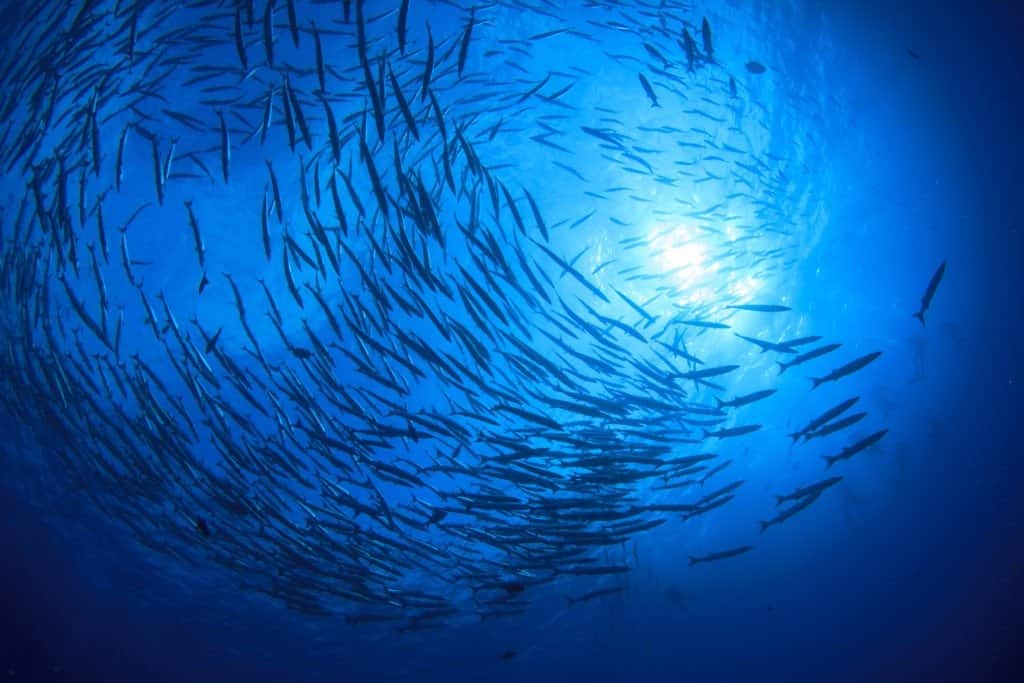
©Rich Carey/Shutterstock.com
If you think barracudas are intimidating, wait until you hear how stealthy they can be. These ambush hunters will lie in wait, stalking their prey until the perfect moment to strike. Since they can reach speeds of 27 mph, it’s easy for them to launch ambush attacks.
Barracudas are carnivorous and love eating other fish. Sometimes barracudas follow their prey in large groups, known as schools.
Stingray Hunting Strategy
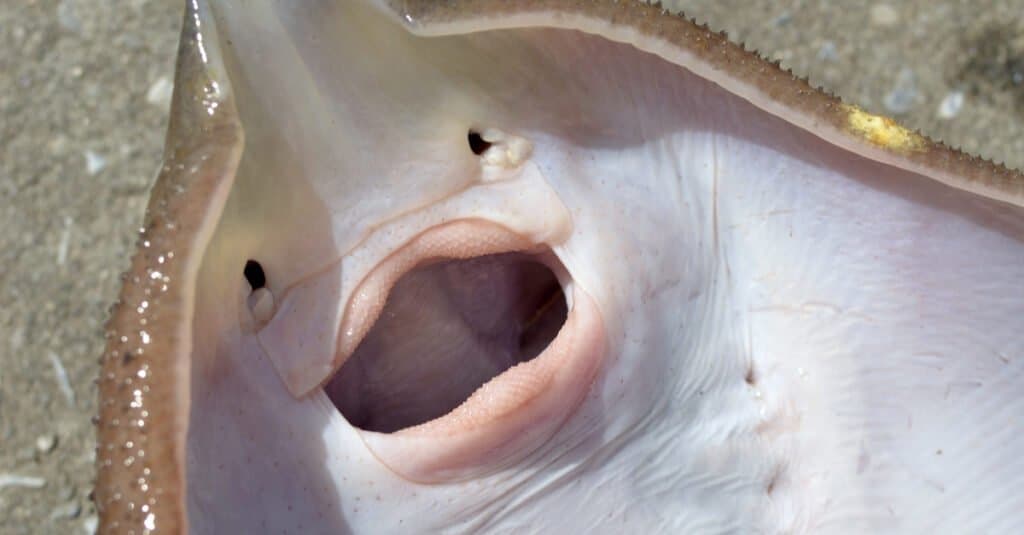
A stingray’s mouth is located on the underside of its body.
©FashionStock.com/Shutterstock.com
Stingrays tend to be docile creatures and prefer to avoid confrontation whenever possible. These bottom-dwellers spend much of their time in the sand or mud, minding their own business. When it’s time to hunt, stingrays use their camouflage to wait for prey.
What do stingrays eat? Instead of stalking schools of fish, stingrays usually go after crustaceans or smaller fish on their own. They can pick up prey on the underside of their body using a special feeding technique. They basically suck the prey into their mouths.
Who Has the Advantage?
Animal battles are the perfect chance to see which animal would have the advantage in a fight. And for this matchup, it’s looking like the incredible barracuda has a few different things going their way, starting with speed. Let’s look at each competitor’s top advantage to see who will have the upper hand.
Barracuda Advantages

Barracudas can swim 27 mph.
©Karelj, Public domain, via Wikimedia Commons – License
Speed is one of the greatest strengths and assets of a barracuda. They can effortlessly glide through the water using their streamlined, torpedo-like bodies.
As if speed wasn’t enough, barracudas also have sharp teeth perfectly designed for eating and catching fish. And since their eyesight is excellent, they can spot prey far away. With their speed and keen senses, barracudas are a force to be reckoned with. But are they strong and stealthy enough to take down a stingray?
Stingray Advantages
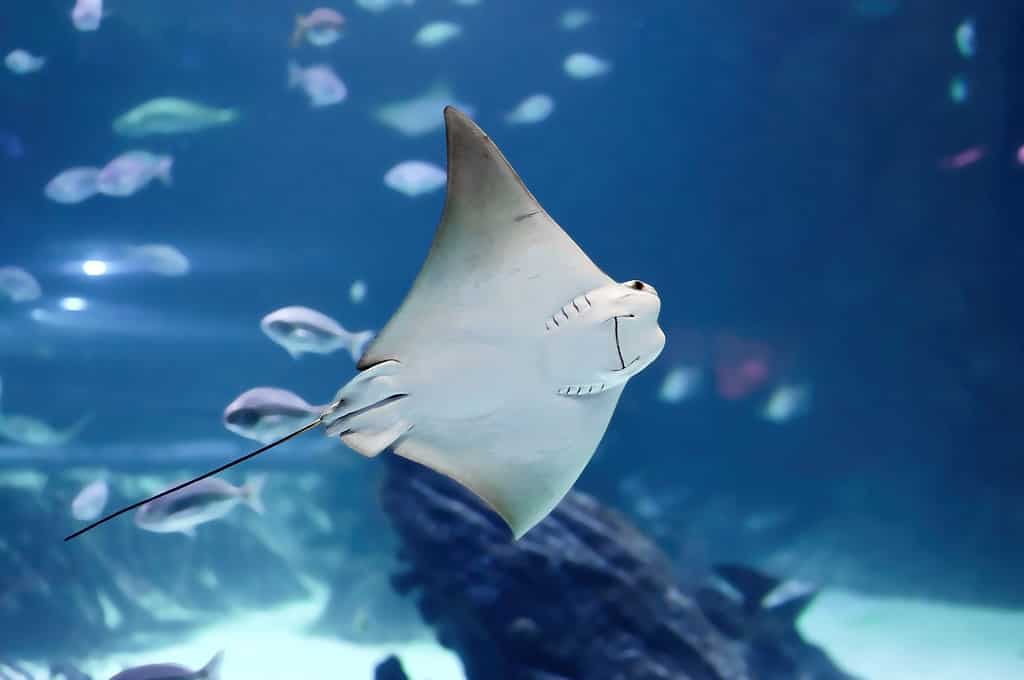
Stingrays have a venomous barb for self-defense.
©BlackFarm/Shutterstock.com
Stingrays, on the other hand, are also masters of stealthy. They know how to blend perfectly with their environment. It’s nearly impossible to detect their presence when they’re hiding in the sand.
If something threatens the stingray, they’ll launch their barb without giving it a second thought. Stingrays can use their strong sense of smell to locate prey buried in the sand or mud. Hopefully, the stingray in this animal battle can sniff out the barracuda. Otherwise, it’ll be too late.
Round 1: Speedy Sprint
Round one for our animal battle is all about speed. Which species is faster? The slim barracuda? Or the sneaky stingray?
Barracudas are nicknamed “speed demons” because they can zip through the water at incredible speeds of 27 mph. Stingrays are also fast, but not quite as fast as their opponent. Using their streamlined bodies, stingrays can glide through the water at speeds of 15 mph. Round one goes to the barracuda. Rather than gliding like a stingray, barracudas can dart through the water.
Round 2: Attack and Defense Techniques
In the animal kingdom, a creature’s ability to attack and defend itself determine its survival rate. Round two will compare the barracuda and the stingray’s attack and defense techniques. Let’s see which animal will win this round.
Barracudas are known for launching lightning-fast attacks using their speed and super-sharp teeth. They can inflict severe damage on unsuspecting prey. And in this case, they could shred the stingray to bits. But they’ll have to find the stingray first.
Stingrays are excellent at camouflage and have some pretty great attack abilities. Using their rough skin and venomous spines, stingrays can deter potential threats. Their rough skin is thanks to dermal denticles; they’re like tiny teeth lining their bodies. These denticles make the stingray’s skin feel like sandpaper.
Once the barracuda finds the stingray, it’ll be game on! The large fish can overpower its flat-bodied competitor using fast, powerful attacks. Round 2 goes to the barracuda.
Round 3: Power Play
Both stingrays and barracudas are incredibly strong. But who’s the toughest? Round three compares the strengths of both of our competitors.
Stingrays have muscular wings, venomous spines, and incredible power. This helps them in offensive and defensive situations. And while barracudas might not be the bulkiest contender, they’re still very muscular. They have strong jaws and the strength to overpower their prey, even if it’s a wide stingray. Round three is a tie. Both of our competitors are incredibly strong in their own ways.
Round 4: Masters of Stealth
It’s time to decide which one of these animals is the sneakiest. Round four is all about stealth. Both animals can be sneaky, but who’s the best at hiding?
Barracudas use their silver or greenish-gray coloration to blend seamlessly into their environment. This is the perfect situation for launching surprise attacks. And as we mentioned earlier, stingrays have flat bodies they can bury in the sand. The barracuda might not even be able to find the stingray before it’s too late. Both competitors play an underwater game of hide and seek on a daily basis to find food and stay safe. Round four is a tie.
Round 5: Size Showdown
We’re getting close to the end of this animal battle. These last two rounds will decide who the winner will be. And round five is all about size.
Barracudas measure between 2 to 5 feet in length. They’re nimble, agile, and fast. Stingrays vary in size from one species to the next. Some are only a few inches wide, while others are several feet wide. Round five goes to the barracuda. Since there aren’t barracudas only a couple of inches wide, they take the win here.
Round 6: Special Abilities Collide
It’s the last round of our animal battle! Round six compares the special abilities of our competitors. Barracudas have razor-sharp teeth, speed, agility, and stealth. All of these abilities help them attack with power or defend themselves.
On the other hand, the stingray’s muscular wings and venomous barbed tail are its secret weapons. They, too, can deliver powerful blows and execute defensive maneuvers. However, since the barracuda has two rows of sharp teeth and the stingray only has one barbed tail, it’s clear who should win this round. Round six is a win for the barracuda.
Who Wins?
The barracuda is the winner of this animal battle. And here’s why. While stingrays eat meat, they’re not the same type of hunter as a barracuda. Barracudas are more direct, fast, and overpowering. If these two animals were to go head to head, it would be easy for the barracuda to launch multiple attacks on the stingray and gain the advantage.
Using its torpedo-like body, the barracuda could slam into the stingray, biting it to bits and ultimately making it lose. Since the stingray’s mouth is on the underside of its body, it’ll be difficult to attack the barracuda with anything but its tail. And having one barbed tail isn’t the same as having two rows of super sharp teeth.
Barracudas are experienced at attacking schools of fish, meaning they’re skilled at attacking multiple animals simultaneously. Stingrays take a more laid-back approach; they’d rather hide in the sand and pop up to eat a crab or two when they’re hungry.
In the real world, these two animals wouldn’t get into a fight. But for this fun and zany animal battle, we have to give the win to team barracuda.
The photo featured at the top of this post is ©
Thank you for reading! Have some feedback for us? Contact the AZ Animals editorial team.







